
In the smashing cover story of the Washington Post Magazine last weekend, Washington, D.C.-based architecture critic Amanda Kolson Hurley makes the case for local Brutalism. Hurley’s 10-page feature, entitled “Crushing on Concrete,” boasts a cover illustration by Peter Chadwick, author of This Brutal World, and includes striking black-and-white photographs by Astrid Riecken.
Hurley’s story begins with a recap of the recent Union Station kerfuffle, “Paintgate,” wherein WMATA whitewashed Harry Weese’s vaults (and faced subsequent backlash), before delving into a primer on the history of Brutalist architecture. Michael Kubo, co-author of Heroic: Concrete Architecture and the New Boston, was interviewed for the article:
There’s this kind of weird valley in which people either love or hate the buildings. I definitely feel like brutalism is in exactly that zone.–Michael Kubo
Despite the losses of some Brutalist buildings Washington, D.C. (namely, Araldo Cossutta’s Third Church of Christ, Scientist, and Marcel Breuer’s American Press Institute), Hurley argues, there have been a few Brutalist triumphs, such as Boston City Hall and U. Mass. Dartmouth’s Claire T. Carney Library by Paul Rudolph. Hurley also exposes the renewal in Brutalism’s popularity, citing the blog F— Yeah, Brutalism, maps by Blue Crow Media, and even our Walk With Locals x Hirshhorn collaboration for last year’s World Architecture Day.
Washington’s impressive catalogue of Brutalist buildings, however, means that the preservation battles are only just beginning. Many of the structures that face greatest peril are those that have aged enough to be in disrepair, yet aren’t quite old enough to have been designated as landmarks. As Hurley puts it, “In Washington … brutalism’s ubiquity means we will have many chances to decide whether it is worth saving.” One notable case in point is the J. Edgar Hoover FBI Building, which tops many a list of “Ugliest Buildings in D.C.” for its impenetrable massiveness. Its future is a story to which we’ll be paying close attention as it develops.
Read the full story at The Washington Post.
For further reading, pick up these Brutalist titles:
Update: Not all of the readers of the WaPo article are concrete lovers, and maybe that’s not news. One particularly scathing comment on the article: “Any chance we get to remove a polyp of this soul-crushing, dismal, ugly architecturally worthless concrete crap from our beautiful city, we should take. It is joyless, ugly and represents all that is sick about sick buildings.” Couldn’t disagree more, chum!
